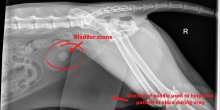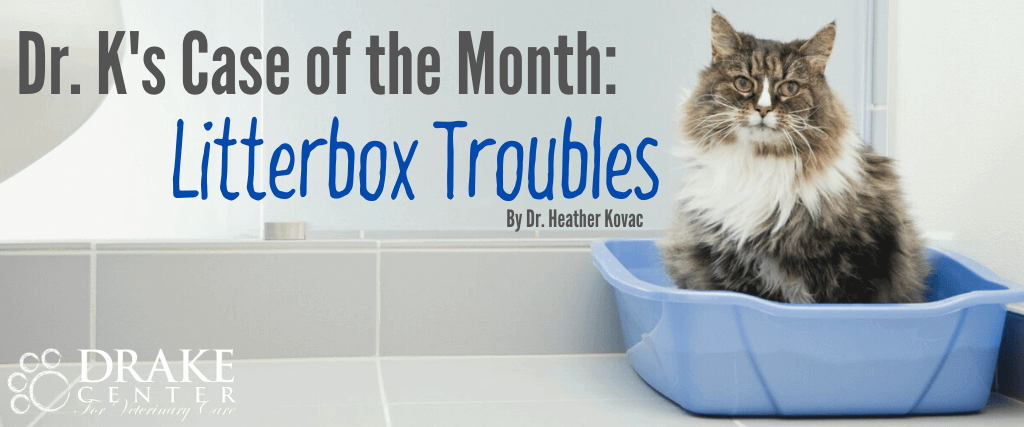By Dr. Heather Kovac
The Patient
Banjo, an 11 year old male neutered domestic shorthair cat, presented for urinating outside the litterbox. He was one of two cats in the household and was indoor only. There were currently 2 litterboxes in the home and the owner cleaned them daily. The two cats were littermates and had lived together their entire lives. They seemed to get along very well. The other cat was using the box normally.

The Case
On physical exam, Banjo seemed uncomfortable on urinary bladder palpation but his bladder was not overly full or hard. His genital region appeared normal. He was about 3 pounds overweight and had mild dental disease. His owners reported that he had been urinating on the floor near the litterbox, on the kitchen counter, in the kitchen and bathroom sinks, and on dirty laundry for at least 2 weeks. They had also seen him use the litterbox normally at times for urination and always for defecation. I recommended that we run some routine labwork on Banjo and take an xray of his abdomen to help determine the cause of the symptoms. The labwork revealed that Banjo had a urinary tract infection and struvite crystals in his urine sample. The pH of the urine was also higher than normal. The xrays revealed that Banjo had a bladder stone. There are several different types of bladder stones in cats. The most common is called a struvite stone. This type of stone forms when the pH of the urine is too high and also often when there is an underlying infection. The stone causes discomfort in the bladder and can lead to straining to urinate or inappropriate elimination. Most struvite stones can be dissolved with antibiotic therapy and a prescriotion diet which lowers the pH of the urine. Stone dissolution takes weeks to months. The second most common type of bladder stone in cats is called a calcium oxalate stone. This type of stone cannot be dissolved and needs to be removed surgically. There is no way to know which type of stone a cat has for sure without removing it surgically and having it analyzed. Since Banjo was in so much discomfort, it was recommended that he have his stone removed the following day.

The Treatment Plan
Banjo was admitted the following day and taken to surgery. This type of surgery is called a cystotomy (opening the bladder to remove a stone). Banjo was placed under general anesthesia and his abdomen was entered in a sterile fashion. The bladder was then isolated and entered after removing the urine with a syringe and needle. The urine was collected and submitted for culture and sensitivity (to determine which bacteria was causing the infection and which antibiotic would be the best choice for treatment). The single bladder stone was removed with a small scoop. The bladder and urethra were flushed with sterile saline and a rubber catheter. The bladder was then closed and the abdomen flushed thoroughly with warm sterile saline. The surgical site was closed routinely. The bladder stone was then submitted to the laboratory for analysis. Banjo recovered well and was sent home later that evening. He was treated with an antibiotic and pain medications. A few days later, his stone analysis revealed that he did indeed have a struvite stone and he was started on a prescription food to help prevent this from happening again. Canned foods are recommended with this disease to ensure adequate hydration and dilute urine production. Banjo will be screened regularly moving forward to ensure he does not get another urinary tract infection or new stone formation.
If your cat is urinating outside the box or straining to urinate, please contact us or you can schedule an examination here.
The Drake Center for Veterinary Care is an AAHA-accredited animal hospital located in Encinitas, CA. The Drake Center loves being a source of information for all pet owners across the country however if you have any questions regarding pet care and do not live in Encinitas, CA or surrounding cities, we encourage you to contact your local veterinarian.

